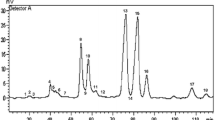Abstract
Olive oils have a higher relative diacylglycerol (DAG) content than other plant oils. The lipase in olive fruits is involved in DAG production and is directly related to the acidity of the olive oil. However, the lipase activity and positional selectivity have not been clarified. To investigate the properties of olive fruit lipase, olive fruits of the Mission variety harvested during mid-December of 2005 on Shodoshima Island (Japan) were stored at 20, 30 or 40 °C for 4 weeks. Changes in the acidity and acylglycerol content of the oils extracted from the stored fruits were analyzed. The acidity and DAG content of the olive oils increased due to triacylglycerol (TAG) hydrolysis during storage. sn-1,2-DAGs preferentially increased during the early stages of storage, indicating that the olive fruit lipase is enantioselective for the sn-3 position, while non-enzymatic isomerization of sn-1,2-DAGs was observed throughout the entire duration of storage. Kinetic analysis revealed that the enantioselectivity of olive fruit lipase for the sn-3 position was approximately four times greater than for the sn-1 position. The lipase was gradually inactivated at temperatures of 30 °C or higher, and the ratios of the rate constant for inactivation to TAG hydrolysis at the sn-3 position was 0.2, 13, and 23 at 20, 30, and 40 °C, respectively.




Similar content being viewed by others
Abbreviations
- TAG:
-
Triacylglycerol
- DAG:
-
Diacylglycerol
- MAG:
-
Monoacylglycerol
- FFA:
-
Free fatty acid
References
D’Alonzo RP, Kozarek WJ, Wade RL (1982) Glyceride composition of processed fats and oils as determined by glass capillary gas chromatography. J Am Oil Chem Soc 59:292–295
Barceló I, Barceló F (1985) Analisis de la Composicion Lipidica del Aceite de Oliva Virgen de Mallorca. Grasas y Aceites 36:269–273
Salas JJ, Sanchez J, Ramli US, Manaf AM, Williams M, Harwood JL (2000) Biochemistry of Lipid Metabolism in Olive and Other Oil Fruits. Prog Lipid Res 39:151–180
Sanchez J, Harwood JL (2002) Biosynthesis of triacylglycerols and volatiles in olives. Eur J Lipid Sci Technol 104:564–573
Pereira JA, Casal S, Bento A, Oliveria MBPP (2002) Influence of olive storage period on oil quality of three Portuguese Cultivars of Oleo europaea, Cobrancosa madural and Verdeal transmontana. J Agric Food Chem 50:6335–6340
Spyros A, Phillippidis A, Dias P (2004) Kinetics of diglyceride formation and isomerization in virgin olive oils by employing 31PNMR spectroscopy. Formulation of a quantitative measure to assess olive oil storage history. J Agric Food Chem 52:157–164
Perez-Camino MC, Moreda W, Cert A (2001) Effect of olive fruit quality and oil storage practices on the diacylglycerol content of virgin olive oils. J Agric Food Chem 49:699–704
Catalano M, De Leonardis T, Comes S (1994) Diacylglycerols in the evaluation of virgin olive oil quality. Grasas y Aceites 45:380–384
Olias JM, Perez AG, Rios JJ, Sanz LC (1993) Aroma of virgin olive oil: biogenesis of the “Green” odor notes. J Agric Food Chem 41:2368–2373
Shimizu M, Moriwaki J, Nishide T, Nakajima Y (2004) Thermal diacylglycerol and triacylglycerol oils during deep-frying. J Am Oil Chem Soc 81:571–576
Itabashi Y, Kukis A, Marai L, Takagi T (1990) HPLC resolution of diacylglycerol moieties of natural triacylglycerol on a chiral phase consisting of bonded (R)-(+)-1-(1-naphthyl) ethylamine. J Lipid Res 31:1711–1717
Watanabea T, Shimizu M, Sugiura M, Sato M, Kohori J, Yamada N, Nakanishi K (2003) Optimization of reaction conditions for the production of DAG using immobilized 1, 3-regiospecific lipase lipozyme RM IM. J Am Oil Chem Soc 80:1201–1207
Villeneuve P, Pina M, Montet D, Graille J (1995) Carca papaya latex lipase: sn-3 stereoselectivity or short-chain selectivity? Model chiral triglycerides are removing the ambiguity. J Am Oil Chem Soc 72:753–755
Rogalska E, Cudrey C, Ferrato F, Verger R (1993) Stereoselective hydrolysis of triglycerides by animal and microbial lipases. Chirality 5:24–30
Author information
Authors and Affiliations
Corresponding author
About this article
Cite this article
Shimizu, M., Kudo, N., Nakajima, Y. et al. Effect of Lipase Activity and Specificity on the DAG Content of Olive Oil from the Shodoshima-Produced Olive Fruits. J Am Oil Chem Soc 85, 629–633 (2008). https://doi.org/10.1007/s11746-008-1243-9
Received:
Revised:
Accepted:
Published:
Issue Date:
DOI: https://doi.org/10.1007/s11746-008-1243-9




